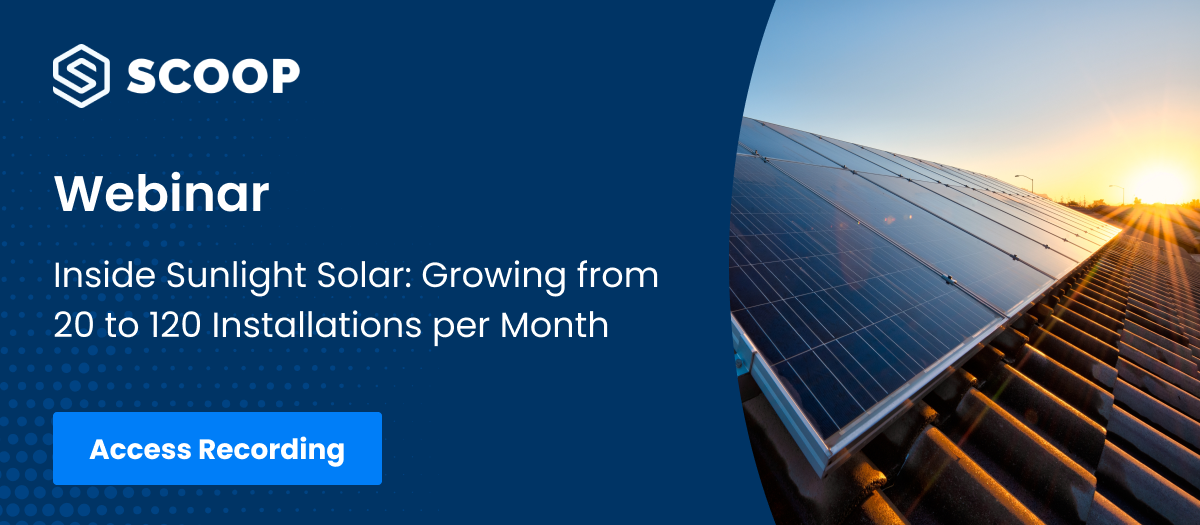Customer communication is far more than just exchanging information. It is at its core about building strong relationships based on trust. It requires anticipating, understanding, and responding to each client’s unique needs, using a variety of channels to ensure clarity, and educating them on the benefits of their investment.
Customer Communication plays an even more important role in the solar & renewables market given the newness of the technology and the corresponding higher need to keep customers informed and educated about the nuances of their projects and services. An effective customer communication strategy not only means less time wasted internally, but also high levels of customer satisfaction, more customer referrals, increased revenue per customer, and higher profit margins.
In this blog, we’ll dive into the different aspects of customer communication, highlighting why it’s so critical and how it shapes the overall client experience. Our discussion will be segmented into key topics:
- What customer communication is exactly
- Why customer communication is vital
- The difference between residential and commercial customer communication
- The main challenges of customer communication
- How to leverage technology to bring your customer communication to the next level
What Exactly Do We Mean by Customer Communications
In the renewable energy sector customer communications go far beyond basic information exchange. It starts with a deep understanding of each client’s unique needs, followed by sharing timely updates and relevant information throughout the installation or maintenance process. Effective communication uses a variety of channels – emails, texts, calls, and even social media – to ensure clarity and convenience. It’s also about educating clients on the technology and its benefits, fostering a deeper understanding and appreciation of their renewable energy investment.
Crucially, good communication extends to robust support and feedback mechanisms, ensuring clients feel heard and valued. This includes managing expectations during unexpected issues or delays with honesty and transparency, which is key to maintaining trust. Even after project completion, continued engagement, whether through energy efficiency tips or updates on new technologies, helps build lasting relationships.
Why Customer Communications Matters
Customer Experience
In the rapidly evolving world of renewable energy, keeping customers informed is crucial. Regular updates about project progress, scheduling changes, or maintenance tips can significantly enhance the customer experience. This constant engagement ensures customers are always aware of what’s happening and feel valued. It’s not just about installing a solar panel or executing routine maintenance on a wind turbine; it’s about fostering a sense of involvement and transparency throughout the process.
Efficiency
Efficiency isn’t just a goal in renewable energy systems; it’s vital in customer communications too. By integrating automation tools with a personalized approach, renewable energy installers, and O&M providers can save precious time. Automated emails or messages for routine updates, combined with personalized calls or visits for more complex issues, strike the right balance. This approach ensures that while your team is freed from repetitive tasks, each customer still feels they are receiving a bespoke service. This efficient communication prevents information overload and ensures that only pertinent information is shared, respecting both the customers’ and the team’s time.
Expectations
Managing expectations is particularly important in industries where the stakes and investments are high. Uncertainty can lead to dissatisfaction, even if the result is positive. You maintain trust by keeping customers informed throughout the installation process, even during unforeseen delays or complications. A well-informed customer is more likely to be understanding and patient. This transparent approach can turn a potentially negative situation, like a delayed installation, into an opportunity to demonstrate your commitment to customer service and reliability.
Referrals
Word-of-mouth and referrals are invaluable. A satisfied customer who feels valued and well-informed is more likely to recommend your services. This is particularly true in a field where personal testimony about efficiency gains or the quality of work can sway decisions. Keeping customers in the loop not only enhances satisfaction but can also lead to higher conversion rates as referrals often tend to be more trusting and inclined towards your services from the outset.
Differentiation
The renewable energy market is competitive, and standing out is crucial. Proactive and personalized communication is a key differentiator. Whether it’s a solar panel installation or a home energy efficiency upgrade, customers remember the service as much as the product. Regular, informative, and customized communications at each step of their journey – from initial inquiry to post-installation support – can set your business apart. Clients will appreciate the extra mile you go in keeping them informed and will likely share their positive experiences with others, enhancing your brand’s reputation and appeal in a crowded marketplace.
What Are The Differences Between Residential & Commercial Customer Communications?
The differences between residential and commercial customer communications in the renewable energy sector are quite distinct, primarily due to the varying scopes, needs, and complexities of these two market segments:
- Scale and Complexity: Residential projects are typically smaller in scale and less complex than commercial projects. Residential communication often focuses on individual homeowner needs, basic installation procedures, and straightforward usage instructions. In contrast, commercial projects are larger, involve more complex systems, and require detailed planning and execution, thus necessitating more comprehensive and technical communication.
- Stakeholder Involvement: Residential communication usually involves direct interaction with a single party – the homeowner. Commercial communications, on the other hand, often involve multiple stakeholders, such as business owners, facility managers, corporate decision-makers, and sometimes even public entities. Each stakeholder might have different concerns and objectives, requiring a varied communication approach.
- Technicality and Detail: Communication in commercial projects tends to be more technical, focusing on aspects like return on investment (ROI), energy savings, scalability, legal compliances, and integration with existing infrastructure. Residential communications might be more focused on practical benefits, cost savings, and the environmental impact of the installation.
- Customization and Personalization: While both sectors require personalized communication, the approach differs. In residential settings, personalization is often about tailoring the message to individual lifestyle benefits and aesthetic preferences. In contrast, commercial personalization might involve aligning the communication with specific business goals, operational requirements, and industry-specific considerations.
- Long-term Engagement and Maintenance: Commercial projects often entail long-term engagement, focusing on maintenance, upgrades, and operational efficiency over time. Residential communications might be more transactional, centered around the immediate sale and installation, with periodic follow-ups for maintenance and service.
- Budget and Financing Communication: Discussions around budgeting, financing, and return on investment are more complex and detailed in commercial communications due to the larger scale of investment. Residential communication might deal more with accessible financing options like loans or grants.
Understanding these differences is crucial for renewable energy providers to tailor their communication strategies effectively to each customer type, ensuring that the specific needs and expectations of both residential and commercial clients are met.
3 Main Challenges With Customer Communications
We’ve spoken with hundreds of renewables professionals to figure out the most common solar customer communication challenges that they (and perhaps you) are facing. Here are 3 of the top issues we uncovered
1) Data From Site Visits is Inconsistent and Incomplete
Crews leaving the site and forgetting to collect key data? Expect extra truck rolls. Missed installation steps? Get ready to pay for costly troubleshooting. All too often, we found, field workers depend on outdated paper checklists—or worse, go by memory during site visits. This leads to incomplete and missing data and leaves you susceptible to big impacts on your costs.
How This is Costing You
Let’s consider a solar company with a team that:
- Has 8 field personnel working on 150 projects a year;
- Incurs about $300 in costs when they roll a truck
- Neglects to collect complete site information 20% of the time.
Based on customer benchmark data, we estimate that this company could pocket an additional $512 per project and add over $75,000 to their bottom line if they addressed this communication issue. That’s huge when NREL estimates that the average profit margin on a $16,000 residential installation in the US is under $2,000.
2) The Customer Communication Delays Snowball Effect
The second communication issue we heard frequently was the delay between when data was collected and when it was available to the rest of the team. With paper forms and phone cameras, field information has to be physically collected, transported, digitized, and compiled.
When juggling several projects concurrently, employees, partners, and contractors can take a long time to send important information to you, or even forget completely. Not only does this drastically slow down projects such as PV installation or commissioning, but it also creates additional administrative follow-up tasks for you and your team.
How This is Costing You
Paper creates chaos; traditional office-bound project and workflow solutions do not make your operations more efficient. On the contrary, they often further slow down your team as hours are wasted with employees re-entering a backlog of stale field data into these systems—data that may not even be relevant any longer!
Consider the data entry costs alone. Let’s say your team completes 100 field reports a quarter, and you’re paying the equivalent of $35/hour for someone at the head office to digitize, compile, and format a report. Our customers report this manual process can easily take 90 minutes or longer, costing you almost $20,000 a year in administrative time for an employee who could have been doing something more valuable.
3) Long Project Status Meetings Sap the Momentum From Your Team
O&M and installation project management teams said they found themselves constantly calling and emailing others—or worse yet, setting up lengthy all-hands meetings—to get the status of different projects and outstanding issues. Constantly reaching out to your employees is time-consuming and annoying. At the same time, you and your team need to collaborate, and projects will collapse in the absence of communication.
Centralizing project activities in one accessible place is the starting point to making it easy for people to find what they need. But this is only possible if the tools have been designed purposefully for your mobile workforce from the ground up. Nearly 100% of work software today is designed for office users, leaving your field team in the dark.
How This is Costing You
If your software is only optimized for desktops or is limited to the office, then it simply isn’t suitable for PV installation and O&M processes, which are field-based and distributed by nature. Symptoms of using the wrong tools include low engagement, missed opportunities to identify issues early on, and an inordinate amount of time spent in meetings communicating status.
We have all seen examples of feature-rich software solutions that turn into very expensive virtual paperweights after a few months. Why? Because they were never adopted by people in the field, who account for up to 80% of the solar workforce. Open communication of project status to all isn’t just essential to you—it’s essential to the well-being of the team.
Ensure Consistent Client Communication & Reporting With Scoop
Scoop Functionalities Enabling Effective Customer Communication
In the context of renewable energy services, where accurate and timely communication is vital, Scoop serves as an invaluable tool for enhancing customer engagement and streamlining workflows. Let’s delve into the specific benefits this technology offers:
- Centralized Operations Hub: Scoop’s centralized operations hub significantly improves customer communication by serving as a unified platform for managing and sharing information. It acts as a single source of truth, where all project data, including service reports, updates, and client interactions, are consolidated. This centralization ensures that both internal teams and clients have access to consistent, up-to-date information.
- Comprehensive Data Collection: Technicians can utilize Scoop to systematically capture crucial information and images during service visits through standardized digital checklists. This process not only ensures that all necessary data is collected but also improves the accuracy and timeliness of this data. It also makes customer information immediately accessible to managers for real-time supervision. Such efficiency is particularly important in complex renewable energy projects where detailed information is critical.
- Tailored Reporting: Scoop’s ability to leverage custom report templates for various service and equipment types enhances the specificity and relevance of communication. For instance, reports for residential EV charger installations can differ significantly from those needed for commercial wind maintenance. These customized templates add a professional touch and ensure that each report is precisely tailored to the project’s requirements.
- Automated Report Generation and Distribution: One of the standout features of Scoop is its capability to automatically generate comprehensive service reports, which include all collected data and images. These reports are then directly emailed to clients, thereby providing them with timely and informative updates about the services rendered. This automation greatly enhances the transparency of the project and strengthens the trust between service providers and clients.
- Timely Progress Updates: Keeping clients informed at each significant stage of the service workflow is crucial. Scoop facilitates this by sending automated progress updates via email at predetermined stages of the project. This feature is instrumental in managing client expectations and maintaining engagement throughout the duration of the service, from the initial assessment to the final checks.
Benefits of Using Scoop vs Traditional Methods
Using Scoop for customer communications presents a notable advantage over traditional methods—gone are the days of endless and disorganized ad-hoc email chains and phone calls. The platform streamlines communication by automating updates and ensuring that they are consistently delivered at crucial project milestones. Such automation saves significant time for both the service provider and the customer, removing the need for manual reminders and follow-ups.
Furthermore, it greatly enhances customer satisfaction, as clients receive timely, relevant information, keeping them engaged and informed throughout the project lifecycle. This efficient and effective communication model is especially beneficial for companies managing a high number of projects or dealing with complex renewable energy projects.
Sunlight Solar’s experience supports this perspective. They faced challenges with manual processes in providing consistent updates to customers. By implementing Scoop, they were able to automate their customer communication, ensuring timely updates aligned with project milestones. This shift significantly improved their customer feedback and subsequently increased sales through referrals, demonstrating the tangible benefits of integrating technology into customer communication strategies.
Reflecting on this transition, Danillo Denzin, Vice President of Sales at Sunlight Solar, shared, “We’ve received fantastic customer feedback due to our improved external communications. Scoop allows us to send automatic email updates to customers at every step of the process.” This statement underscores the positive impact of adopting technological solutions for customer communication in enhancing customer satisfaction and business growth.
Conclusion
As we conclude our exploration of customer communications within the renewable energy sector, it’s evident that this aspect is not just about the transfer of information but about building relationships, trust, and understanding. Effective communication is a strategic asset, pivotal in enhancing customer satisfaction, increasing revenue, and improving profit margins. Through this blog, we’ve examined the multifaceted nature of customer communications, delving into its importance, the challenges faced, and the innovative ways technology, particularly tools like Scoop, can elevate these interactions to new heights.
Are you ready to impress your customers? Schedule a call with one of our dedicated experts to explore how Scoop is the missing piece to your customer communication puzzle.



